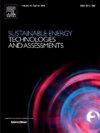Insight into pyrolysis behavior and upgrading of waste oil distillation residue via thermal analysis, kinetics, and thermodynamics
IF 7.1
2区 工程技术
Q1 ENERGY & FUELS
Sustainable Energy Technologies and Assessments
Pub Date : 2025-07-10
DOI:10.1016/j.seta.2025.104445
引用次数: 0
Abstract
Although waste oil processing technologies were maturing, the waste oil distillation residues (WODR) generated during the process remained difficult to utilize effectively due to their high toxicity and asphaltene content. This became a bottleneck in advancing waste oil resource recycling. In this context, it was significant to have an insight into the pyrolysis behavior and upgrading of WODR via the integrated evaluation of physicochemical properties, thermal analysis, kinetics, and thermodynamics. The results indicated that WODR exhibited a higher coking tendency than waste oil, primarily attributed to the obvious heavy fraction content (∼42 %), lower H/C (∼1.81), and decreased CH2/CH3 (∼1.416). The heating rate exerted an obvious influence on pyrolytic behaviors, involving threshold, peak, and termination temperatures, and maximum mass loss rate. Besides, the gas production revealed that CH4, CO, and CO2 mainly arose in 300–550 ℃. Moreover, the variations of the activation energy with the conversion were respectively 126.5–512.02 kJ∙mol−1 and 121.08–448.22 kJ∙mol−1 for Friedman and OFW methods. And Pearson’s correlation analysis validated these kinetic findings. Furthermore, the thermodynamic analysis indicated an endothermic and non-spontaneous process for the WODR pyrolysis. From this study, it could provide updated understanding on the WODR pyrolysis to promote the high-value utilization of the whole waste oil.

通过热分析、动力学和热力学深入了解废油蒸馏残渣的热解行为和升级
虽然废油处理技术日趋成熟,但在此过程中产生的废油蒸馏残渣由于其高毒性和沥青质含量而难以有效利用。这成为推进废油资源化利用的瓶颈。在此背景下,通过物理化学性质、热分析、动力学和热力学的综合评价来了解WODR的热解行为和升级具有重要意义。结果表明,WODR比废油表现出更高的焦化倾向,主要原因是其重馏分含量明显(~ 42%),H/C较低(~ 1.81),CH2/CH3较低(~ 1.416)。升温速率对热解行为有明显影响,包括起始温度、峰值温度、终止温度和最大质量损失率。产气量分析表明,CH4、CO和CO2主要产生于300 ~ 550℃。弗里德曼法和OFW法的活化能随转化率的变化分别为126.5 ~ 512.02 kJ∙mol−1和121.08 ~ 448.22 kJ∙mol−1。Pearson的相关分析证实了这些动力学发现。热力学分析表明,WODR热解过程为吸热非自发过程。本研究可为WODR热解提供新的认识,促进全废油的高价值利用。
本文章由计算机程序翻译,如有差异,请以英文原文为准。
求助全文
约1分钟内获得全文
求助全文
来源期刊

Sustainable Energy Technologies and Assessments
Energy-Renewable Energy, Sustainability and the Environment
CiteScore
12.70
自引率
12.50%
发文量
1091
期刊介绍:
Encouraging a transition to a sustainable energy future is imperative for our world. Technologies that enable this shift in various sectors like transportation, heating, and power systems are of utmost importance. Sustainable Energy Technologies and Assessments welcomes papers focusing on a range of aspects and levels of technological advancements in energy generation and utilization. The aim is to reduce the negative environmental impact associated with energy production and consumption, spanning from laboratory experiments to real-world applications in the commercial sector.
 求助内容:
求助内容: 应助结果提醒方式:
应助结果提醒方式:


